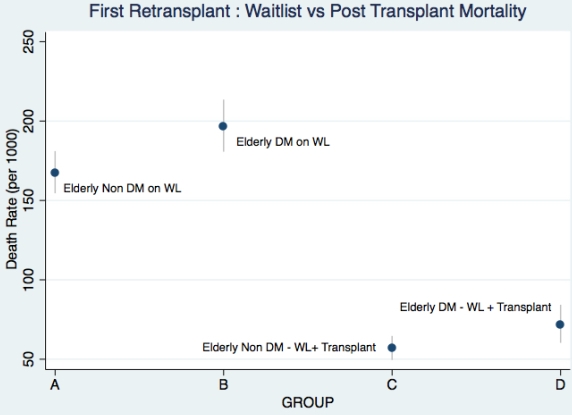Retransplantation of the Elderly Diabetic: To Do Or Not to Do?
A. Naik, A. Sakhuja, D. Cibrik, M. Samaniego.
Division of Nephrology, University of Michigan, Ann Arbor, MI.
Meeting: 2015 American Transplant Congress
Abstract number: 383
Keywords: Elderly patients, Mortality, Waiting lists
Session Information
Session Name: Concurrent Session: Kidney: Cardiovascular and Metabolic
Session Type: Concurrent Session
Date: Tuesday, May 5, 2015
Session Time: 2:15pm-3:45pm
 Presentation Time: 3:27pm-3:39pm
Presentation Time: 3:27pm-3:39pm
Location: Terrace I-III
INTRODUCTION: An increasingly common cause of transplantation is retransplantation. Often, a dilemma exists as to which patients should be considered for retransplantation especially when the potential recipient is an elderly diabetic patient. The benefit of retransplantation in the elderly diabetic patient remains unclear.
METHODS: Using the OPTN/UNOS database, we analyzed potential kidney transplant recipients from 2001-2010 who were wait-listed for first retransplantation. Patients less than 60 years of age at the time of listing, multiorgan transplants and those having a prior non-renal transplants were excluded. Four groups were created. Group A consisted of elderly non-diabetics on the waitlist (WL) , Group B consisted of elderly diabetics on the WL. Group C consisted of elderly non-diabetics who were on the WL and received a second kidney transplant and Group D consisted of elderly diabetics who were on the WL and received a second kidney transplant. A non-proportional Cox regression model adjusted for relevant covariates using transplantation as a time varying covariate was used to estimate hazards for remaining on waitlist versus retransplantation. KM survivor curves were constructed and crude mortality rates per 1000 were calculated.
RESULTS:3627 patients were available for analysis. Mean age at listing was 64.8 years. Median age was 64 years while IQR for age (25%-75%) was 61-67 years. Median waitlist time (including inactive time) at time of death on waitlist (Group A & B) or those that were transplanted (Group C & D) was 1004, 873, 423 and 397 days respectively. Using Group A (non-diabetic on WL) as a reference, hazards for Group B (diabetic on WL) was HR=1.22, P= 0.001), Group C (non diabetic WL now transplanted): HR= 0.30, P<0.001, Group D (diabetic WL now transplanted); HR = 0.41, P= <0.001. Median survival time across Group A to D was 4.1, 3.4, 9.25 and 8.0 years, respectively.

CONCLUSION: Both elderly diabetic and non-diabetic patients that survive waitlist period and get retransplanted have good long-term survival. Efforts should be made to retransplant elderly candidates in a timely fashion to minimize mortality.
To cite this abstract in AMA style:
Naik A, Sakhuja A, Cibrik D, Samaniego M. Retransplantation of the Elderly Diabetic: To Do Or Not to Do? [abstract]. Am J Transplant. 2015; 15 (suppl 3). https://atcmeetingabstracts.com/abstract/retransplantation-of-the-elderly-diabetic-to-do-or-not-to-do/. Accessed January 1, 2026.« Back to 2015 American Transplant Congress
